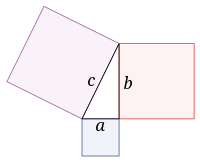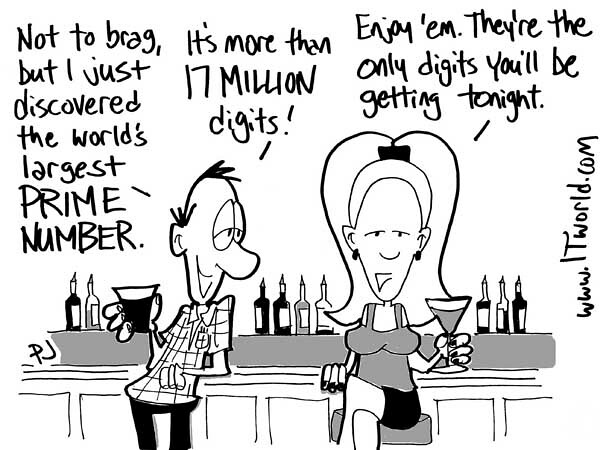Ten Mathematical Facts You Won’t Believe! Number Six Will Shock You!
by Sarah Lonberg-Lew
Mathematics and its history are rich with surprising events and results. Here are ten mathematical tidbits and stories you won’t believe! (And some of them you shouldn’t believe because they aren’t all true — see if you can figure out which ones are! The answers are at the end.)

1. Pythagoras (he of the famous theorem) and his followers were so upset by the discovery of irrational numbers that they drowned the man who discovered them. The Pythagoreans believed in an orderly universe and that everything in it could be described by simple, clean, whole numbers, or ratios of whole numbers. When it was discovered that using the Pythagorean Theorem to find the hypotenuse of a right triangle whose legs were each 1 resulted in a number that could not be expressed as the ratio of two whole numbers, the Pythagoreans were scandalized and poor Hippasus was drowned in the Mediterranean Sea for the crime of bringing this unpleasant fact to light.
2. The number of hours in one day is 4!.
3. If there are 50 people in a room, the probability that two of them will have the same birthday is almost 50%.
4. Mathematicians are still looking for the last digit of pi. Supercomputers have been working on it for years and have churned out trillions of digits, but so far the last digit has yet to be found. In university math departments around the world, people have placed bets on what the last digit will be. What do you think it will be?
5. Calculus and calcium come from the same Latin word, and calcium is a component of chalk, which is often used to do calculus!
6. The largest prime number that has been discovered is 282,589,933 – 1. It has 24,862,048 digits. It was found by Patrick Laroche in 2018 by running free software on his computer. You can participate in the search for the next one. If you find one that has more than 100,000,000 digits, you could win $150,000! (A prime number is a number that has exactly two factors, one and itself.)
7. Famous nurse Florence Nightingale was also a pioneering statistician who created a new way to make data visual. She used graphs called coxcombs (kind of like circle graphs but with more information) which allowed her to show detailed data about the causes of mortality of soldiers in the Crimean war and to document the positive effects of her efforts to improve sanitation.
8. If you could count one number every second without stopping, it would take you just over five days to count to one million.
9. The title of this column was a lie. There are only nine mathematical “facts” in this column (including this one).
The Answers
1. Probably not true. This legend has been around for a long time, and there was a man called Hippasus who was a fifth-century Pythagorean, but there’s no solid evidence that he was drowned for discovering the square root of two. Other stories report that he revealed Pythagorean secrets or that someone else was drowned for publicizing irrational numbers, but no one knows for sure if any of these stories are true. (https://plato.stanford.edu/entries/pythagoreanism/)
2. True! Okay… it may not be true if you’re reading that exclamation point as punctuation at the end of the sentence, but in mathematical notation, the exclamation point indicates a factorial, a special kind of mathematical notation that means to multiply the number by all the whole numbers less than it. In this case, 4! = 4 x 3 x 2 x 1 = 24. (And there is a period at the end of that sentence… go back and look.)
3. False! In fact, the truth is even more interesting. It only takes 23 people in a room for the chances of two of them having the same birthday to be 50%. If you have 50 people in a room, the probability is even higher – there is a whopping 96.5% chance that two people in the room will have the same birthday! (https://www.scientificamerican.com/article/bring-science-home-probability-birthday-paradox/)
4. False! In 1761, pi was proven to be irrational by Johann Heinrich Lambert. That means the digits will keep going forever. No end is in sight, nor will it ever be. Luckily, only a few decimal places are necessary to make calculations that are accurate enough for most applications.
5. True! In fact, calculus, calcium, and chalk all come from the Latin word “calx” which means stone. Calculus is a diminutive form that literally means “small stone.” The words calculus, calculate, and calculator all come from the Latin word used to describe pebbles used as counters. In medical contexts, calculus can also refer to a kidney stone or gallstone or to the plaque on your teeth!
6. True! Anyone with a computer can download free software from the Great Internet Mersenne Prime Search (GIMPS) and let their computer do the work. Since 1996, GIMPS has found 17 large prime numbers. The Electronic Frontier Foundation awarded prizes for the first prime with one million digits and the first prime with ten million digits. The next prize will be for the first prime found with one hundred million digits. (https://www.mersenne.org/ and https://www.eff.org/awards/coop)
7. True! You can see two of her original graphs here: https://understandinguncertainty.org/coxcombs
8. False! Counting one number every second, it would take you over 11.5 days to count to one million. Can you figure out how long it would take to count to one billion?
9. True! Don’t believe everything you read!

Lonberg-Lew has been teaching and tutoring math in one form or another since college. She has worked with students ranging in age from 7 to 70, but currently focuses on adult basic education and high school equivalency. She teaches in an adult education program in Gloucester, MA. Sarah’s work with the SABES Mathematics and Adult Numeracy Curriculum & Instruction PD Center at TERC includes developing and facilitating trainings and assisting programs with curriculum development. She is the treasurer for the Adult Numeracy Network.

